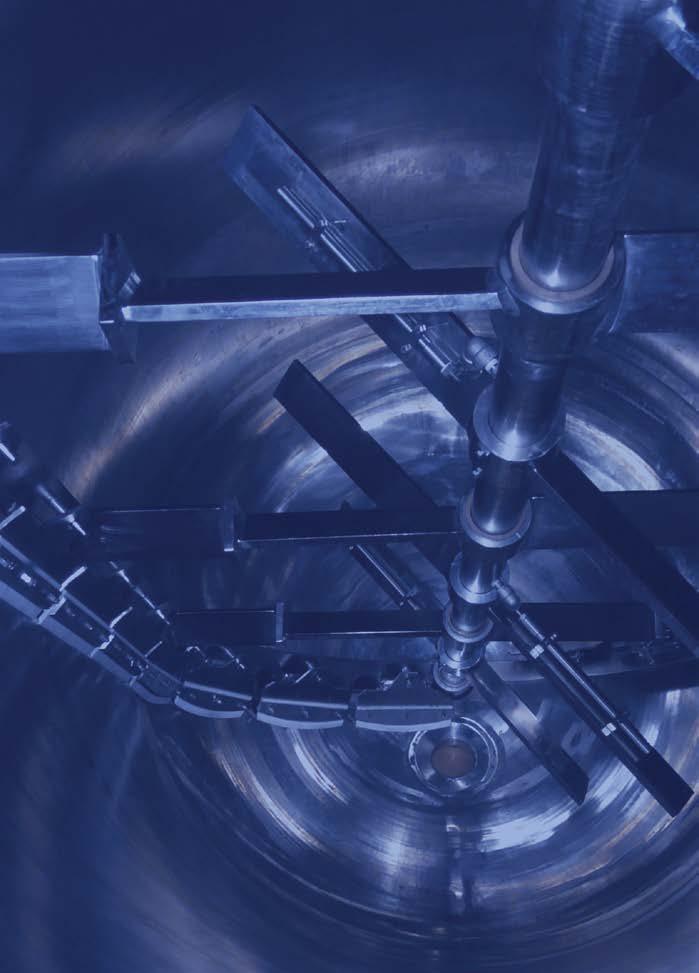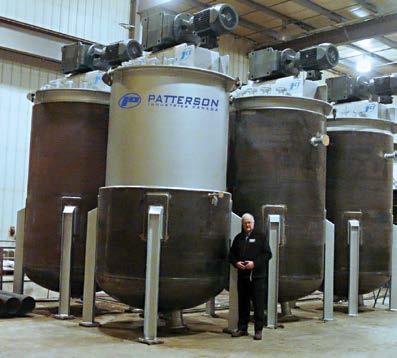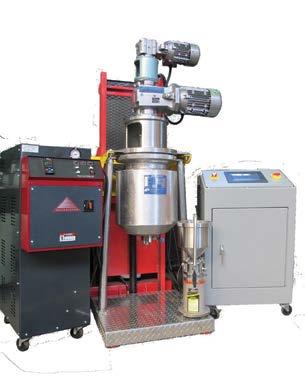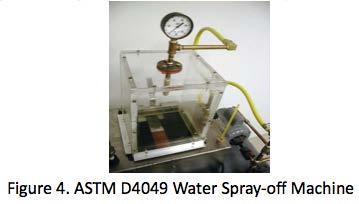
13 minute read
Polymers to Enhance the Performance of Inorganic Grease
David A. DeVore, Daniel M. Vargo, and Brian M. Lipowski Functional Products Inc.
Abstract
A selection of polymers including PIB, OCP/EPDM, grafted OCP, and PIP was added to inorganic greases. The materials studied were mineral oil based Bentonite clay thickened and Silica thickened greases. The addition of polymers into grease changes its ability to resist water spray-off as measured by ASTM D4049. Water spray-off performance can be related to the adhesive property of the grease to the metal surface. Water washout properties were also evaluated. The effect of low temperatures on greases containing polymer additives was measured using the US Steel Grease Mobility test.
Introduction
Lubricating grease comprises two phases and three components: base fluid, thickener, and other performance additives. The liquid phase is primarily formed by the base fluid and dissolved performance additives. The solid phase is formed by a network of soap molecules or a dispersion of solid particles such as inorganic clays or other fillers such as silica.1 Generally, the soap thickener is a metallic salt of a long-chain fatty acid, e.g. lithium 12-hydroxy stearate, which can assemble into a network structure in solution. Inorganic fillers cannot assemble into a network structure. The solid phase thickener can consist of soap molecules or inorganic fillers with or without added polymer. The base oil solubilizes polymers and performance additives and is immobilized by the soap molecule network structure, resulting in a semi-solid to solid appearance.2 These properties are influenced by the selection of base oil, thickener and other additives.
Polymers incorporated into the grease can be used to enhance the properties of the grease such as consistency, shear stability, water resistance, adhesion, tackiness, and soap yield.3,4 Polymers such as polyethylene, polypropylene, polyisobutylene, halogenated polyethylene, polymethacrylate and polyurea are reported to improve the properties of greases.1,5,6 Olefin copolymers (OCPs), styrene-ethylenebutylene (SEBS) and OCP-anhydride (OCP-A) were studied. The type and structure of polymer selected has significant impact on grease properties including low temperature flow, thickening efficiency and shear stability.7
Base greases
The selection of the base fluid used to make the grease has a large impact on the low temperature properties. At low temperatures, paraffinic oils containing significant portions of saturated hydrocarbons generally crystallize which impedes flow.8 Certain pour points depressants are effective at disrupting these wax crystal structures and can improve flow at low temperatures but generally require a higher treat level.9
Unlike paraffinic oils, naphthenic oils generally do not contain high levels of molecules that can crystallize at low temperature. The viscosity increase at low temperature is generally due to purely thickening effects as described by the viscosity index. Naphthenic oils are generally preferred over paraffinic oils for low temperature use.9,10
More recently, synthetics including polyalphaolefins and esters have been used as base fluids in greases for use at low temperature.9,11 Similar to paraffinic oils, polyalphaolefins may contain components that crystalize at low temperature. Esters may also exhibit poor low temperature properties if, during use, cleavage of the esters into alcohols occurs.
The selection of the thickener also has an impact on the performance of grease used at low temperature. As machine design evolves operating conditions that the grease must endure has become more severe. Also, the expectation is increased machine productivity and less downtime. This has made it difficult for lithium greases to satisfactorily fulfill these requirements. The National Lubricating Grease Institute (NLGI) GC-LB specification requires greases to surpass simple lithium 12-hydroxystearate greases.
Greases formed using inorganic fillers such as Bentonite clay or fumed silica are generally used in high temperature applications. These can include oven doors, bearings operated under lowload and low-speed conditions and chain lubricants. These types of greases are preferred in these applications because, unlike soap-based greases, they do not demonstrate a dropping point. There is no degradation of the inorganic filler at high temperature and therefore
The physical form of clay and silica thickeners consists of spheres or platelets. This large surface area effectively thickens the grease to a very smooth, buttery texture which is non-melting allowing it to perform very well after careful consideration is given to its intended application.12
Inorganic base greases are somewhat less flexible in terms of the polymer additives that will be effective. This is due to the fact that there is no soap network for the long polymer chains to entangle with or, in the case of functionalized materials, bond with. This limits the success of polymer additives to cases where a sufficiently strong polymer network can be formed in the absence of a soap network. Thus, it is more difficult to improve properties such as water resistance of base grease.
The lack of a soap network also results in grease that does not stiffen and reduce in flow at lower temperatures. This is not generally a concern for inorganic greases as they tend to be used in high temperature applications. However, pumping grease into the locations to be lubricated may occur at lower temperatures where flow is more important. The low temperature properties of inorganic greases are driven by the low temperature properties of the base oil and the components that are dissolved therein such as polymers.
Water Resistance
To be most effective in any application a grease must have a certain affinity for the surfaces being lubricated. This affinity or adherence can be measured by several different tests that are known in the industry. Water spray-off and water washout are two of the most commonly used tests.
The adherence of grease to the substrate is characterized by water spray-off or water washout measurements.12 In the water spray-off test, a greased metallic surface is subjected to direct water spray at elevated temperature and the adherence is determined based on the mass of grease lost over a certain time period.13, 14 ASTM D 4049, “Standard Test Method for Determining the Resistance of Lubricating Grease to Water Spray.” This test provides a realistic determination of how much grease will be removed when water is sprayed on it. Panel weights were determined to the nearest 0.1 g and after a 0.8 mm (1/32 in.) thick film of grease was applied to the panels they were reweighed. Any grease outside the scribe lines was removed before reweighing. The panels were inserted into the holders and then into the water spray apparatus as shown in Figure 4. The panel was centered below the spray nozzle. Water at 100 ºF was sprayed at a pump pressure of 276 kPa (40 psi) onto the panel for 5 minutes. Grease outside the scribe lines was removed, and the panels were dried in an oven for 1 hour at 150 ºF and reweighed. The percent grease weight loss was reported as the percent water spray-off.
Water Washout Test
Method ASTM D1264 tests the resistance of a grease to being washed out from a wheel bearing. The grease is packed in a ball bearing, the bearing is then inserted in a housing with specified clearances, and rotated at 6006 30 rpm. Water, at 79°C impinges on the bearing housing at a rate of about 5 mL/s. The amount of grease washed out in 1 h is a measure of the resistance of the grease to water washout.
Grease Mobility Test
Grease mobility at 0°F was measured by the US Steel Grease mobility method. Grease flow is a complex phenomenon determined by many factors. The most important factor is temperature. As the temperature decreases a grease will have poorer mobility. Other factors include thickener type and amount, base oil properties and other mobility improvers.
The most readily pumpable or dispensable greases are made from lithium complex or aluminum complex soaps. Less readily pumpable greases are based on calcium complex and calcium sulfonate type soaps. Calcium sulfonate greases contain a higher level of soap to attain a particular NLGI grade compared to lithium complex greases. This accounts for the decreased flow rate of calcium sulfonate greases.
The base oil accounts for 80 to 90% of a typical grease. Therefore, its properties strongly influence grease flow. High viscosity base oils result in lower mobility greases; however, in machinery operation these greases provide better lubricity through increased film thickness. Base oils with low viscosity indexes generally have poorer mobility at lower temperatures. Higher base oil pour points indicate the presence of waxy components, which restrict mobility as they crystallize at low temperature.
Mobility improvers are generally low pour point, low viscosity oils or solvents. These can include synthetic esters and polyalphaolefins.13
Water spray-off test
Water resistance of the grease samples was determined using
Materials
The base greases used were a NLGI Grade 2 clay grease containing 8.5% clay filler in ISO 460 paraffinic bright stock base oil with 0.5% antioxidant and no additional additives and a NLGI Grade 2+ fumed silica grease containing 9.2% silica. The base oil viscosity was 117 cSt at 40°C, and is a 600 Neutral Group 1 base stock.
Polymers were incorporated into the base grease by mixing in a Hobart mixer at 80°C. The polymer additives used in this study were in solutions of mineral oil and are shown above in Figure 3. Polymers were added and mixed for 3 hours to ensure complete solubilization of the polymer.
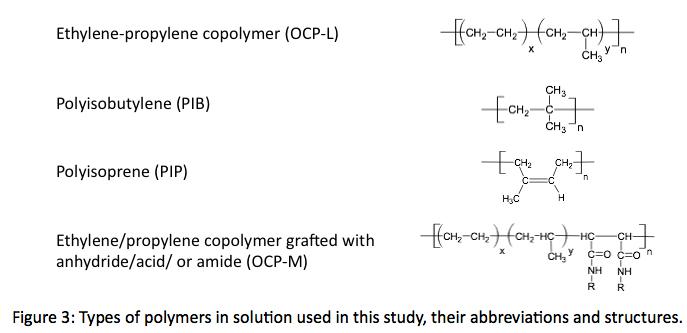
Experimental Methods
Cone Penetration
The NLGI consistency grade of each of the unworked samples used in this study was determined using one-quarter scale cone penetration following ASTM D1403.
Water Spray-off
The water spray-off was determined by ASTM D4049.
Water Washout
The water washout was determined at 79°C (175°F) following ASTM D1264 by an outside laboratory.
US Steel Mobility Test
The U.S. Steel mobility test determines the resistance of lubricating grease to flow at a given temperature and pressure. Mobility is determined by the flow rate of the grease through a pressure viscometer.14 Typically the pressure viscometer is constructed of stainless steel and is fitted with a No. 1 (40:1 ratio) capillary. With the sample at the test temperature, the flow of grease is started under the selected pressure using a nitrogen tank and regulator. Typical test pressure is 150 psi and temperatures of ambient, 32°F, 20°F, 10°F, and 0°F. Flow rate, usually measured in grams per second, is determined by collecting the grease for a specified period.
The samples used in this testing were run at 150 psi and 32°F. Lower temperatures were not evaluated due to the pervasiveness of inorganic greases in high temperature applications.
Adding polymer additives to the silica base grease does not benefit the water spray-off performance of the grease. This is likely due to the fact that there is no soap network for the second polymer network to entangle with resulting in decreases effectiveness. Due to the ineffectiveness of the polymer additives in benefitting the water sprayoff water washout testing was not performed with the silica based greases.
The polymer additives were added as solutions in light naphthenic oil. This resulted in softening of the greases containing the polymer additives. To counteract this, the grease formulator would need to decrease the amount of starting oil in the formulation resulting in a higher concentration of inorganic thickener.
Mobility
Adding polymer to the silica grease resulted in decreased flow as compared to the base grease. OCP-M had the greatest flow. Polymer molecules become more rigid as the temperature decreases. This rigidity decreases the overall flow of the grease.
Unworked penetration data
In all cases addition of liquid polymer additives to the silica base grease softened the grease. Presumably addition of the additional oil along with the polymer caused the increase in cone penetration values. As stated above the polymer becomes less effective at thickening without a soap matrix with which to entangle.
Adding solutions of polymer in oil softens the grease relative to the base grease as occurred in the cases of PIB, OCP-M, and OCP-L. The advantage is that this allows for a reduction in the base oil charge to obtain the desired consistency. The PIP stiffens the base grease because the solvent is removed from the PIP and no additional oil is added with the PIP charge unlike the other polymer components.
Water spray-off
For the clay based grease we see significant improvement in water sprayoff when 1% PIP or 4% OCP-M are added. Adding OCP-L has no effect on water spray-off while adding 1% PIB is detrimental to performance. This is likely due to adding a minimal amount of very high molecular weight PIB and a proportionally larger amount of oil.
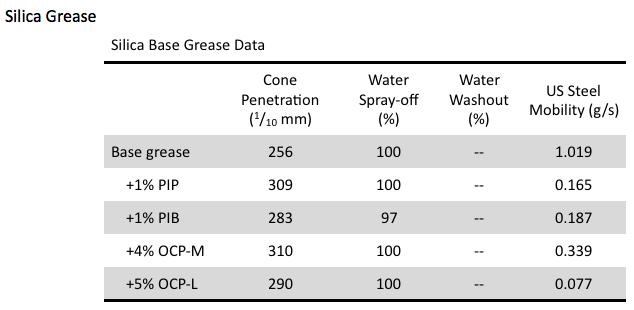
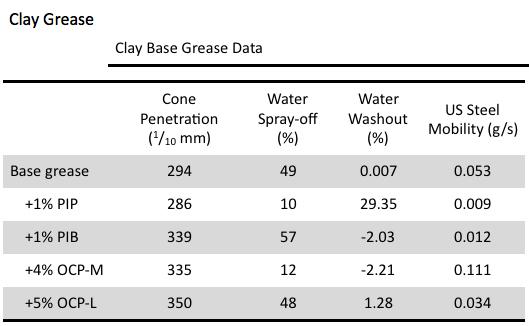
Water washout
The base grease without polymer had essentially zero water washout meaning that no grease was removed from the bearing. Addition of polymer resulted in poorer performance for all of the polymer additives with the exception of OCP-L. The negative results obtained with PIB and OCP-M indicate that mass was gained during the test, presumably from entrapped water.
Mobility
Adding polymer to the clay grease resulted in decreased flow as compared to the base grease except for the OCP-M which had improved flow. Polymer molecules become more rigid as the temperature decreases. This rigidity decreases the overall flow of the grease. (1) In A Comprehensive Review of Lubricant
Chemistry, Technology, Selection, and Design;
Rizvi, S. Q. A., Ed.; ASTM International, 2009; pp. 443–496.
(2) Silverstein, S.; Rudnick, L. R. In Lubricant Additives
Chemistry and Applications; Rudnick, L. R., Ed.;
CRC Press: New York, 2009; p. 586.
(3) Larson, B. K.; Mroczek, W. In NLGI Annual
Meeting; 2009.
(4) Vargo, D. M. In NLGI 81st Annual Meeting; Palm
Beach Gardens, FL, 2014.
(5) Scharf, C. R.; George, H. F. NLGI Spokesm. 1996, 59, 4–16.
(6) Levin, V. NLGI Spokesm. 2004, 68, 25–32.
(7) Fish, G.; Ward, W. C. In ELGI 25th Annual Meeting;
Amsterdam, 2013.
(8) Baczek, S. K.; Chamberlin, W. B. In Encyclopedia of Polymer Science and Engineering; John Wiley &
Sons, 1988; p. 22.
(9) Denis, R. A.; Sivik, M. R.; George, H. F. In NLGI 69th Annual Meeting; Coronado, CA, 2002.
(10) Rizvi, S. Q. A. In A Comprehensive Review of
Lubricant Chemistry, Technology, Selection, and
Design; Rizvi, S. Q. A., Ed.; ASTM International, 2009; p. 38.
(11) Coffin, R. In STLE 2013 Annual Meeting Education
Course: Synthetic Lubricants 203-Non-Petroleum
Fluids & their Uses; STLE: Detroit, 2013; p. 70.
(12) Scott, R. In Basic Handbook of Lubrication;
Zabawski, E.; Melley, R.; Wissner, P.; Scott, R.;
Morrison, J., Eds.; STLE-Alberta Section, 2011; pp. 188–198.
(13) Fish, G.; Ward, W. C. In STLE 2012 Annual Meeting; STLE: St. Louis, MO, 2012.
(14) Conley, P.; Shah, R. In NLGI 70th Annual Meeting;
Hilton Head, SC, 2003.
Conclusion
Adding certain polymers to the clay grease effectively improves water spray-off however other properties such as grease mobility and water washout can be negatively affected. Using OCP-M results in a clay based grease with significantly improved water spray-off performance and improved flow as measured by the US Steel mobility test.
It is known that polymers generally require a soap matrix with which to interact. This interaction or interpenetration allows the polymer to effectively improve both water washout and spray-off.
In the absence of a soap matrix, judicious selection of polymer additives is required to attain an inorganic grease with the best blend of performance attributes.
Acknowledgements
Functional Products Inc. would like to thank like to thank Tony Wenzler and Rob Haak of Battenfeld Grease and Oil Corp. of NY for supplying the clay base grease and John Sander and Joanne Moore of Lubrication Engineers for supplying the silica base grease.


